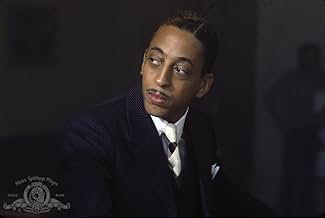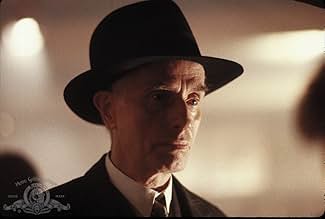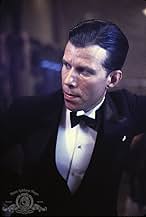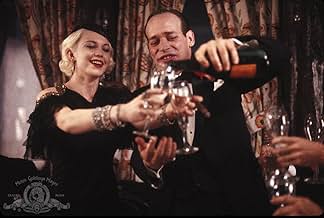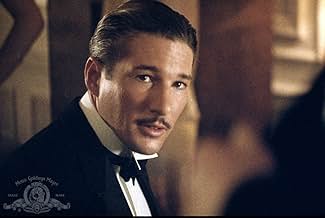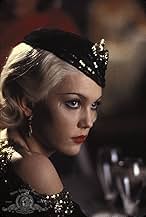CALIFICACIÓN DE IMDb
6.6/10
21 k
TU CALIFICACIÓN
Conoce a los músicos de jazz, bailarines, propietarios e invitados del Cotton Club en el Harlem de 1928 a 1930.Conoce a los músicos de jazz, bailarines, propietarios e invitados del Cotton Club en el Harlem de 1928 a 1930.Conoce a los músicos de jazz, bailarines, propietarios e invitados del Cotton Club en el Harlem de 1928 a 1930.
- Dirección
- Guionistas
- Elenco
- Nominado a 2 premios Óscar
- 1 premio ganado y 9 nominaciones en total
Laurence Fishburne
- Bumpy Rhodes
- (as Larry Fishburne)
John P. Ryan
- Joe Flynn
- (as John Ryan)
Opiniones destacadas
The first time I saw this movie I loved the music and dancing and appreciated the setting. I found it strange and couldn't follow it properly. I watched it a second and third time, partly to see the dancing again, and listen to the music, and the plot completely grew on me. I absolutely love this movie. It is complex, and extremely accurate in its portrayal of the time when gangsters owned stars. If you love jazz music and know a little about its history, you will be enraptured by this movie.
The acting is incredible, and highlights the subtle twists in the plot beautifully. The cinematography is done in a most expert fashion. Richard Gere and Gregory Hines are absolutely charming, and Diane Lane is perfect is Vera Cicero. Lonette McKee has one of the most beautiful voices you will ever hear, it is no wonder she received a Tony award. Any viewer will be surprised by the guest appearances including Nicholas Cage, Bob Hoskins, Lawrence Fishburne, and on-screen and real-life brother of Gregory, Maurice Hines. Not only one of Coppola's best, but one of the best of all time.
The acting is incredible, and highlights the subtle twists in the plot beautifully. The cinematography is done in a most expert fashion. Richard Gere and Gregory Hines are absolutely charming, and Diane Lane is perfect is Vera Cicero. Lonette McKee has one of the most beautiful voices you will ever hear, it is no wonder she received a Tony award. Any viewer will be surprised by the guest appearances including Nicholas Cage, Bob Hoskins, Lawrence Fishburne, and on-screen and real-life brother of Gregory, Maurice Hines. Not only one of Coppola's best, but one of the best of all time.
Even Francis Ford Coppola couldn't sustain the height of movie-making he achieved in the 1970s. Raised too high by initial expectations, then dismissed too brusquely when the critics got to see it, "The Cotton Club" exists in a kind of neutral zone, a grand spectacle undone by sloppy scriptwriting and unappealing characters that nevertheless shows the master with some juice still in his cup.
It's the story of Dixie Dwyer (Richard Gere), a cornet player who one evening in 1928 almost accidentally saves the life of notorious mob boss Dutch Schultz (James Remar). Dutch, already a fan of his music, is appreciative of the extra service and brings Dwyer into his circle, which brings him into contact with Dutch's girl Vera (Diane Lane).
"If I didn't like you, you'd be dead," is Dutch's way of expressing friendship.
"It's nice to be liked," Dixie replies.
The film is centered around the nightclub of the title, a fashionable Harlem nightspot where blacks are welcome only on stage, entertaining the white customers. Owney Madden (Bob Hoskins) runs things with an eye for keeping order, especially where the volatile Dutchman is concerned. Sandman Williams (Gregory Hines) just wants to dance into the arms of Lila Rose (Lonette McKee), who is torn between the chance for true love versus the chance to pass for white in a white man's world.
The stacked cast even includes Nicolas Cage as Dixie's mad-dog gangster brother and Laurence Fishburne in one of his first signature tough-guy roles. "The white man has left me nothing but the underworld, and that is where I dance," he tells Sandman. "Where do you dance?" All this crammed into just over two hours leaves very little room to breathe, for a director who mastered movies which do exactly that. But with little useful dialogue except of the expository kind, characters coming and going all the time, left-field plot twists (Dixie goes to Hollywood and becomes an instant star), and a central romance between Gere and Lane that is long on open-mouth kissing but short on story, you need spectacle to keep your attention.
Remar makes the film worthwhile for me. His bug-eyed tantrums as Dutch are what stay with me when the film is over, yet he shows range, too, shy with Vera, henpecked with his wife, and amiable with Dixie in his guarded way. It's hard not to worry what will happen when he learns about Dixie and Vera, not only for the lovebirds but for Dutch, too. I only wish Remar could have played Dutch in the latter film set in the same milieu, "Billy Bathgate"; Dustin Hoffman is a great actor but was wrong for that part. Remar here fits into it like a cement overshoe.
The film also boasts great music, including singing from McKee and tapping from Hines and his brother Maurice that raise the roof and recall the famous baptism scene in Coppola's first "Godfather". Larry Marshall does a great Cab Calloway, conked locks whipping across his forehead.
Nothing is really wrong with "Cotton Club". But what's right doesn't stay right for long, and the rest doesn't hold together. It's a fun show, so long as you don't mind being a bit confused when the curtain comes down.
It's the story of Dixie Dwyer (Richard Gere), a cornet player who one evening in 1928 almost accidentally saves the life of notorious mob boss Dutch Schultz (James Remar). Dutch, already a fan of his music, is appreciative of the extra service and brings Dwyer into his circle, which brings him into contact with Dutch's girl Vera (Diane Lane).
"If I didn't like you, you'd be dead," is Dutch's way of expressing friendship.
"It's nice to be liked," Dixie replies.
The film is centered around the nightclub of the title, a fashionable Harlem nightspot where blacks are welcome only on stage, entertaining the white customers. Owney Madden (Bob Hoskins) runs things with an eye for keeping order, especially where the volatile Dutchman is concerned. Sandman Williams (Gregory Hines) just wants to dance into the arms of Lila Rose (Lonette McKee), who is torn between the chance for true love versus the chance to pass for white in a white man's world.
The stacked cast even includes Nicolas Cage as Dixie's mad-dog gangster brother and Laurence Fishburne in one of his first signature tough-guy roles. "The white man has left me nothing but the underworld, and that is where I dance," he tells Sandman. "Where do you dance?" All this crammed into just over two hours leaves very little room to breathe, for a director who mastered movies which do exactly that. But with little useful dialogue except of the expository kind, characters coming and going all the time, left-field plot twists (Dixie goes to Hollywood and becomes an instant star), and a central romance between Gere and Lane that is long on open-mouth kissing but short on story, you need spectacle to keep your attention.
Remar makes the film worthwhile for me. His bug-eyed tantrums as Dutch are what stay with me when the film is over, yet he shows range, too, shy with Vera, henpecked with his wife, and amiable with Dixie in his guarded way. It's hard not to worry what will happen when he learns about Dixie and Vera, not only for the lovebirds but for Dutch, too. I only wish Remar could have played Dutch in the latter film set in the same milieu, "Billy Bathgate"; Dustin Hoffman is a great actor but was wrong for that part. Remar here fits into it like a cement overshoe.
The film also boasts great music, including singing from McKee and tapping from Hines and his brother Maurice that raise the roof and recall the famous baptism scene in Coppola's first "Godfather". Larry Marshall does a great Cab Calloway, conked locks whipping across his forehead.
Nothing is really wrong with "Cotton Club". But what's right doesn't stay right for long, and the rest doesn't hold together. It's a fun show, so long as you don't mind being a bit confused when the curtain comes down.
Part fictional and part non-fictional, this lavish two-hour Francis Ford Coppola film spotlights the Cotton Club, the legendary, real-life Harlem jazz nightclub that flourished in the Prohibition era of the late 1920s and early 1930s. Richard Gere plays Dixie Dwyer, a young musician who works for mobsters, in an effort to advance his career. Dwyer falls in love with Vera Cicero (Diane Lane), the girlfriend of gangster Dutch Schultz (James Remar). The Dwyer character is based loosely on real-life jazz trumpet player Bix Beiderbecke.
Throughout the film, various gangsters and bootleggers interact, sometimes violently, but much of the action centers around the Cotton Club, an establishment owned in real-life by Owney Madden, played in the film by actor Bob Hoskins. Madden would bring in Black performers to entertain a Whites-only clientèle, a truly racist policy, and a major plot point in the film's story.
The film's plot is somewhat muddled, the result of a less than stellar screenplay. And, as you would expect, the gangster characters are not terribly likable. But the film overcomes these script weaknesses with a captivating visual and musical style that is both tawdry and elegant. The corruption, the violence, and the implied sleaze are garish and tawdry to be sure. Yet, the Club's ambiance gushes with a certain elegance and glamour. It's a strange mix, but one that is entirely consistent with that era in U.S. history.
The film gets points from me for its lush, period piece costumes and production design, and adroit lighting, as well as all those jazz numbers, both sultry and flashy. Gregory Hines together with brother Maurice Hines provide some snappy tap dancing, some of which is improvised. Interestingly, their grandmother really did perform at the Cotton Club during its heyday. Also of interest in the film, viewers get to watch towering Fred Gwynne, who plays Frenchy, the oh-so-serious assistant to Owney Madden; the two of them engage in some interesting dialogue.
Although the script's story and characters are less than ideal, I enjoyed the film a lot, mostly as a result of the tawdry and elegant visual style combined with the lavish jazz numbers. If you're interested in gangster movies or the Prohibition era of American history, this film is a must-see.
Throughout the film, various gangsters and bootleggers interact, sometimes violently, but much of the action centers around the Cotton Club, an establishment owned in real-life by Owney Madden, played in the film by actor Bob Hoskins. Madden would bring in Black performers to entertain a Whites-only clientèle, a truly racist policy, and a major plot point in the film's story.
The film's plot is somewhat muddled, the result of a less than stellar screenplay. And, as you would expect, the gangster characters are not terribly likable. But the film overcomes these script weaknesses with a captivating visual and musical style that is both tawdry and elegant. The corruption, the violence, and the implied sleaze are garish and tawdry to be sure. Yet, the Club's ambiance gushes with a certain elegance and glamour. It's a strange mix, but one that is entirely consistent with that era in U.S. history.
The film gets points from me for its lush, period piece costumes and production design, and adroit lighting, as well as all those jazz numbers, both sultry and flashy. Gregory Hines together with brother Maurice Hines provide some snappy tap dancing, some of which is improvised. Interestingly, their grandmother really did perform at the Cotton Club during its heyday. Also of interest in the film, viewers get to watch towering Fred Gwynne, who plays Frenchy, the oh-so-serious assistant to Owney Madden; the two of them engage in some interesting dialogue.
Although the script's story and characters are less than ideal, I enjoyed the film a lot, mostly as a result of the tawdry and elegant visual style combined with the lavish jazz numbers. If you're interested in gangster movies or the Prohibition era of American history, this film is a must-see.
Francis Ford Coppola's The Cotton Club is every bit as dazzling, chaotic and decadent as one might imagine the roaring twenties would have been. it's set in and revolves around the titular jazz club, conducting a boisterous, kaleidoscope study of the various dames, dapper gents, hoodlums, harlots and musicians who called it home. Among them are would be gangster Dixie Dwyer (a slick Richard Gere), Sandman Williams (Gregory Hines), a young Bumpy Johnson (Laurence Fishburne) and renowned psychopathic mobster Dutch Schultz (a ferocious James Remar). Coppola wisely ducks a routine plot line in favor of a helter skelter, raucous cascade of delirious partying, violence and steamy romance, a stylistic choice almost reminiscent of Robert Altman. Characters come and go, fight and feud, drink and dance and generally keep up the kind of manic energy and pizazz that only the 20's could sustain. The cast is positively stacked, so watch for appearances from Nicolas Case, Bob Hoskins, Diane Lane, John P. Ryan, James Russo, Fred Gwynne, Allen Garfield, Ed O Ross, Diane Venora, Woody Strode, Giancarlo Esposito, Bill Cobbs, Sofia Coppola and singer Tom Waits as Irving Stark, the club's owner. It's a messily woven tapestry of crime and excess held together by brief encounters, hot blooded conflict and that ever present jazz music which fuels the characters along with the perpetual haze of booze and cigarette smoke. Good times.
One gets the sense that 'The Cotton Club (1984)' will improve upon repeat viewings, once you've become accustomed to what director Francis Ford Coppola was attempting. After all, this is a gangster film from the man who brought us 'The Godfather (1972)' and its sequels – what else could we expect but another Corleone saga? The film we're delivered is nothing of the sort, a testament to the director's constant willingness to take risks and experiment with new ideas. Indeed, rather than trying to emulate Coppola's former successes, 'The Cotton Club' could more accurately be described as a "gangster musical," a realisation that took me until the film's second half. Do those two genres even go together? Perhaps taking inspiration from Herbert Ross' 'Pennies from Heaven (1981)' – and the mini-series on which it was based – the film blends the ugly brutality and corruption of the Prohibition- era with the dazzling bright lights of the Cotton Club, Harlem's premiere night club. It is this deliberate but uneasy juxtaposition of reality and fantasy that fuels Coppola's vision, an ambitious undertaking without a dominant focus.
The film's major storyline concerns Dixie Dwyer (Richard Gere), a comparatively ordinary jazz musician who unexpectedly finds himself associating with organised crime boss "Dutch" Schultz (James Remar). Dixie is interesting because, unlike your typical hero consumed by the allure of amoral riches, he always remains peripheral to the world of gangsters; he observes, with disapproval, its dishonesty and depravity, but rarely finds himself a part of it. In fact, the closest he ever comes to being a gangster is in Hollywood, where he shares the sort of film roles that made James Cagney and Edward G. Robinson famous. Coppola might have been offering a commentary on the inherently romanticised version of reality offered by the movies, but his "real world" of gangsters is scarcely less stylised. The seedy underbelly of organised crime is paradoxically depicted as taking place in the classiest locales in Harlem, where the crime bosses consume the best alcohol and mix with Hollywood's elite talent (Chaplin, Swanson and Cagney among the featured patrons).
Proving further that Coppola wasn't attempting to replicate his Corleone saga, 'The Cotton Club' also features a rather extraneous subplot with Maurice and Gregory Hines as African-American tap-dancers vying for the "big-time" at the Cotton Club, where (in a bizarre discriminatory switch) only black performers are hired. The regular cross-cutting between this story and Dixie Dwyer's doesn't quite work, and, in any case, the taut romance between Dwyer and tough-girl Vera (an absolutely gorgeous Diane Lane) is much more involving than that between Sandman Williams (Gregory Hines) and mixed-race dancer Lila (Lonette McKee). Among the film's impressive supporting performers are Bob Hoskins and Fred Gwynne as crime associates, Nicholas Cage as an overly-ambitious young thug, Laurence Fishburne as black crime boss Bumpy Rhodes, and James Remar, playing a sleazier and less identifiable version of Dutch Schultz to Dustin Hoffman in 'Billy Bathgate (1991).' The premiere gangster film of 1984 was Leone's 'Once Upon a Time in America (1984),' but, despite being runner-up, nobody can accuse Coppola of playing it safe.
The film's major storyline concerns Dixie Dwyer (Richard Gere), a comparatively ordinary jazz musician who unexpectedly finds himself associating with organised crime boss "Dutch" Schultz (James Remar). Dixie is interesting because, unlike your typical hero consumed by the allure of amoral riches, he always remains peripheral to the world of gangsters; he observes, with disapproval, its dishonesty and depravity, but rarely finds himself a part of it. In fact, the closest he ever comes to being a gangster is in Hollywood, where he shares the sort of film roles that made James Cagney and Edward G. Robinson famous. Coppola might have been offering a commentary on the inherently romanticised version of reality offered by the movies, but his "real world" of gangsters is scarcely less stylised. The seedy underbelly of organised crime is paradoxically depicted as taking place in the classiest locales in Harlem, where the crime bosses consume the best alcohol and mix with Hollywood's elite talent (Chaplin, Swanson and Cagney among the featured patrons).
Proving further that Coppola wasn't attempting to replicate his Corleone saga, 'The Cotton Club' also features a rather extraneous subplot with Maurice and Gregory Hines as African-American tap-dancers vying for the "big-time" at the Cotton Club, where (in a bizarre discriminatory switch) only black performers are hired. The regular cross-cutting between this story and Dixie Dwyer's doesn't quite work, and, in any case, the taut romance between Dwyer and tough-girl Vera (an absolutely gorgeous Diane Lane) is much more involving than that between Sandman Williams (Gregory Hines) and mixed-race dancer Lila (Lonette McKee). Among the film's impressive supporting performers are Bob Hoskins and Fred Gwynne as crime associates, Nicholas Cage as an overly-ambitious young thug, Laurence Fishburne as black crime boss Bumpy Rhodes, and James Remar, playing a sleazier and less identifiable version of Dutch Schultz to Dustin Hoffman in 'Billy Bathgate (1991).' The premiere gangster film of 1984 was Leone's 'Once Upon a Time in America (1984),' but, despite being runner-up, nobody can accuse Coppola of playing it safe.
¿Sabías que…?
- TriviaWhen Francis Ford Coppola called up Bob Hoskins to offer him a part, the actor didn't believe it was really him. Coppola introduced himself, to which Hoskins replied, "Yeah, and this is Henry the fucking Eighth", and hung up.
- ErroresDuring the montage song Ill Wind there is a shot of coins and bills being poured out. The dimes in the shot are Roosevelt dimes, not produced until 1946.
- Créditos curiososIn the original version, the opening credits were intercut with dancers performing "The Mooche." In the 2019 revision, the dancing is eliminated and the credits roll straight through, but have been joined with straight cuts rather than dissolves. Additionally, Coppola has changed his billing from "Francis Coppola" to "Francis Ford Coppola." Finally, restoration credits have been added after the end titles.
- Versiones alternativasIn 2019, Lionsgate released a director's cut running 139 minutes, titled "The Cotton Club Encore". This version gave more space to the Williams brothers and Lila Rose, restoring three full musical numbers and extending others, and trimming scenes with impersonations of 1920s celebrities.
- ConexionesEdited into Lonette McKee: Ill Wind (1984)
- Bandas sonorasHow Come You Love Me Like You Do?
Written by Gene Austin and Roy Bergere
Selecciones populares
Inicia sesión para calificar y agrega a la lista de videos para obtener recomendaciones personalizadas
- How long is The Cotton Club?Con tecnología de Alexa
Detalles
- Fecha de lanzamiento
- País de origen
- Idiomas
- También se conoce como
- El Cotton Club
- Locaciones de filmación
- Prospect Hall, Brooklyn, Nueva York, Nueva York, Estados Unidos(church, order given at bar, Hoofer's Club, ballroom proposal)
- Productoras
- Ver más créditos de la compañía en IMDbPro
Taquilla
- Presupuesto
- USD 58,000,000 (estimado)
- Total en EE. UU. y Canadá
- USD 25,928,721
- Fin de semana de estreno en EE. UU. y Canadá
- USD 2,903,603
- 16 dic 1984
- Total a nivel mundial
- USD 25,928,721
- Tiempo de ejecución2 horas 9 minutos
- Color
- Relación de aspecto
- 1.85 : 1
Contribuir a esta página
Sugiere una edición o agrega el contenido que falta

Principales brechas de datos
By what name was El Cotton Club. Centro de la mafia (1984) officially released in India in English?
Responda


